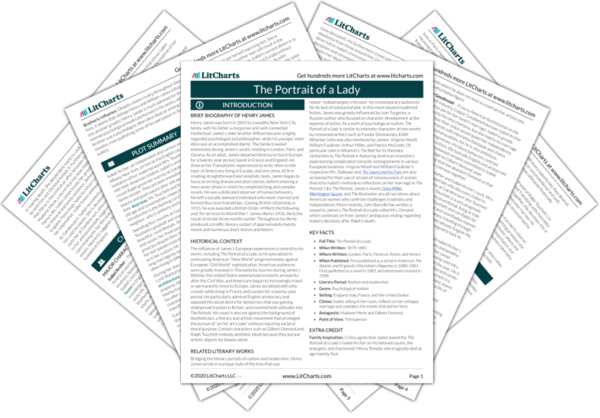Summary
Analysis
The Countess Gemini wishes to live in Rome, as her own home in Florence is unexciting, and accepts her brother Osmond’s invitation to stay with his family for a period. The Countess Gemini is convinced that Isabel leads a more exciting life than her own, but she is not envious of her sister-in-law. Isabel, meanwhile, is slightly intimidated by the Countess but enjoys her company.
The Countess Gemini is not envious of Isabel, despite Isabel’s exciting lifestyle, because the Countess knows that Osmond is a cruel man. She tried to warn Isabel before she was married, but Isabel did not want to hear about Osmond’s flaws.
Themes
Before the Countess Gemini leaves for Rome, Henrietta Stackpole visits her in Florence for help. The Countess has helped the journalist once before regarding a newspaper article. Henrietta claims that Osmond has tried to break up her friendship with Isabel. The Countess Gemini is not surprised to hear this and encourages Henrietta not to allow Osmond to have his way.
Henrietta hopes to repair her friendship with Isabel, despite Henrietta’s objections to Osmond and Osmond’s subsequent obstruction of the women’s friendship. It is likely that Osmond resents Henrietta’s aversion to him and her efforts to free Isabel from the marriage. Henrietta’s dogged pursuit of a relationship with Isabel is typical of her American New World fortitude.
Themes
Henrietta plans to visit Isabel in Rome to see if she can repair their friendship. The journalist is worried about Isabel because the tone of her letters has changed. The Countess Gemini, known as a great gossip, informs Henrietta that Lord Warburton is trying to get close to Isabel again. The Countess offers an idea for working out whether Isabel is truly unhappy in her marriage to Osmond, which Henrietta rejects as too complex. The Countess is impressed by Isabel’s strength of friendships.
In her straightforward manner, Henrietta decides that the best way to check whether Isabel is alright is to simply visit Isabel in Rome.
Themes
While returning to her hotel in Florence, Henrietta leaves a note for Caspar Goodwood, who is also currently in the city. She asks that he visit her this evening. However, she accidentally bumps into him earlier than expected while looking at the “Correggio of the Tribune” (The Virgin Adoring the Christ Child) at the Uffizi, a painting that depicts the Madonna kneeling adoringly over the delighted Baby Christ. Goodwood is polite but disinterested in engaging with Henrietta. The journalist insists that he honor his friendship to Isabel by going to Rome to help her in her unhappy marriage. After some persuasion, Goodwood agrees, even if only from a sense of duty that if Henrietta is insistent on traveling to Rome, he must accompany her.
Despite Caspar Goodwood’s reluctance at becoming involved in Isabel’s life again, Henrietta is still certain that he is the right man for Isabel. Her powers of persuasion are quite remarkable. Henrietta and Goodwood’s accidental meeting in front of the painting symbolic of Henrietta and Goodwood’s relationships with Isabel—they adore Isabel in a similar manner to the scene played out in the painting. The artwork can also represent Isabel’s relationship to Pany, as the stepmother has come to adore her charge.
Themes
Get the entire The Portrait of a Lady LitChart as a printable PDF.













